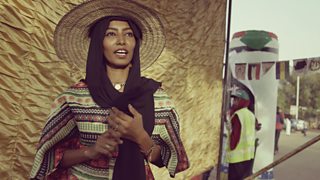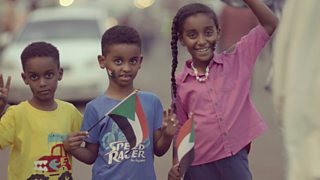Six months ago the Sudanese people rose up against the thirty year dictatorship of Omar al Bashir. My film - Sudan’s Bloody Uprising - tells the story of what happened after Bashir fell.
Meeting Namariq

Khartoum is full of hope when I arrive. Protestors are demanding that the military hand over power. There’s a carnival atmosphere at their camp, music fills the air. Soldiers are sent to break up the sit-in but the protestors hold firm.
I only have 10 days in the country. I need a subject that will tell the story of the revolution. My original plan is to cover Sudan Revolution Radio, the station that launched earlier this year and has become the voice of the protestors. But then I meet Namariq.
Namariq is a doctor. She is also a protestor but her parents don’t know that. When I discover she is from Atbara I realise this is the central character I need. I think: “What a great story if we can travel to Atbara and meet her family.” Atbara is known as the cradle of the revolution. It was there in December that protests broke out, protests that spread and in April resulted in Bashir’s fall.
Heading out of the capital
The practicalities are not so straightforward. Working in the capital is much easier than the regions. The government won’t give us permits to film in Atbara. We must get ad hoc local permission. It is exciting to be the only western journalists working in the region. But it comes with danger.
Atbara is 350km (220 miles) north east of Khartoum. The journey takes us eight hours as we avoid the main road with its police checkpoints. Journalists venturing outside Khartoum must be careful, so we take many precautions.
Namariq’s family are very welcoming, as are many of the locals. This is the first time people here have seen western journalists with a camera. But I feel in danger at the hospital. A protestor who has lost a brother in the protests has asked me to film there so we go along and start filming. Two policemen show up. One of them grabs me. Before this moment I’d said to Namariq, there’s no way this country could go back to bloodshed. Now I realise I was wrong. I see how ingrained violence is, how comfortable the police and army are using violence. Luckily in this case the protestors help me get away.
The hardest moment to film is a scene where Namariq is taking part in a protest at the market. She still hasn’t told her family that she is a protestor. Unbeknownst to her, her father arrives and spots her. He wanders over. I have no idea what’s going to happen next but in fact’s he’s calm. Namariq though is mortified when she sees him and looks at her shoes. It’s a revealing scene. It’s lucky we capture all this in such a short time - about three to four minutes. Then suddenly it’s not safe. I have a guy watching my back and he barks at me to get away. He’s seen something. We pile into the car and drive off. That’s the way it works. I am doing the filming myself with a small local team supporting me. You have to listen to the people around you.

A family dilemma
The climax of the visit to Atbara is when Namariq sits down with her mother and father for a family meeting. While they sip their tea she confesses that she is a protestor. And says she wants to go back to the capital to rejoin the sit-in. Her parents are alarmed. The family lost her brother last year. It is her mother not her father who insists she stay. It is a tense scene, here are two strong women going head to head. In the end Namariq gets up with the tea tray. She decides to give way. She has had to choose between country and family. It’s very hard. She agrees to stay in Atbara.
The role of women in Sudan is so striking. They call it kandaka. That’s the word for queen, dating back to the ancient Kingdom of Kush. Kandaka has been used in the recent protests to describe the many women who have played a vocal part in the protests. And here we see it in Namariq’s own family.
Still alive, still defiant
When I leave Sudan my lasting impression of the people is fear, courage and defiance. In their faces I see hope but also a lack of trust - it’s no wonder when you think what happens a few weeks later.
On 3 June the Sudanese military launched a crackdown on the Khartoum protests. It’s thought more than 120 protestors are killed and others are raped. Namariq would have been there if she’d had her way. I am so relieved that she is safe and well. Her family may have saved her life. Her dream of going back and continuing the protest died. But she continues to protest in Atbara.
She’s still alive, still defiant and she still believes in what she does.
Namak’s documentary, Sudan’s Bloody Uprising, is available on 主播大秀 iPlayer now.
